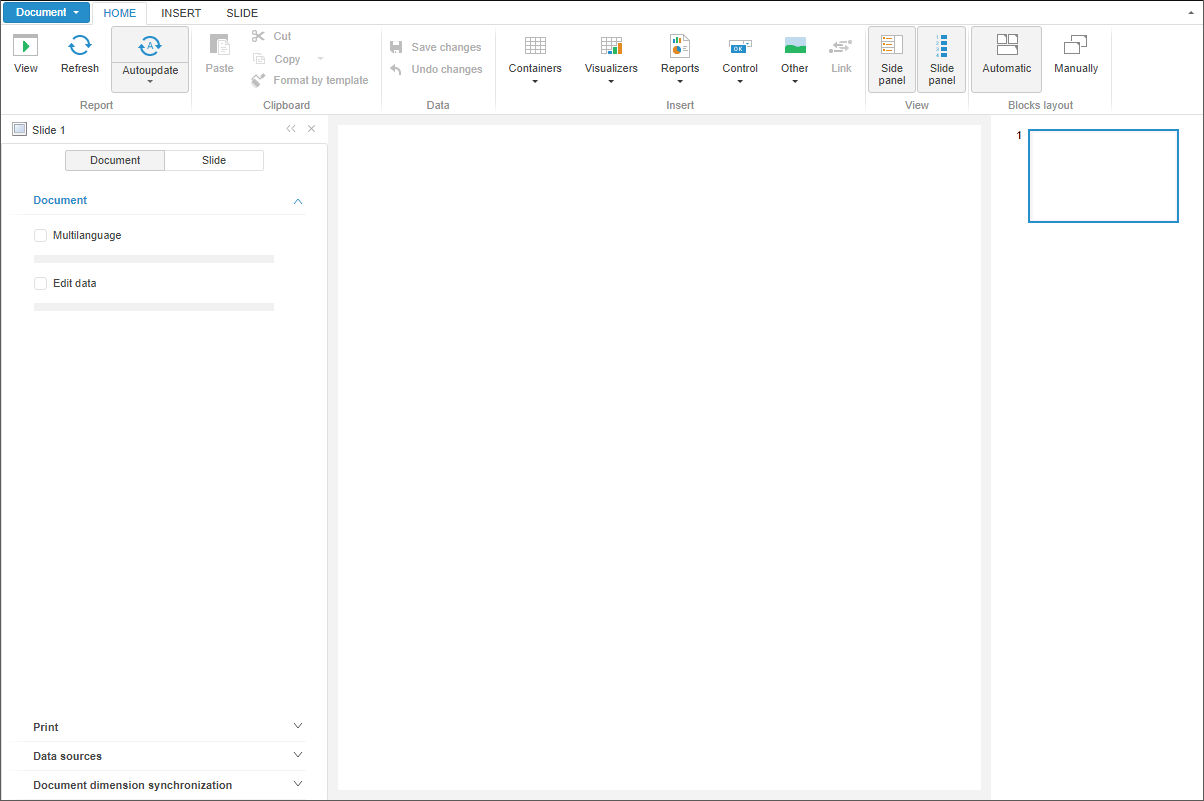
Kap.KapBox (settings)
settings. JSON object that contains parameters applied on creation of the KapBox component.
The following parameters are available:
| Parameter Name | Type | Brief description |
| Mandatory parameters: | ||
| Metabase | PP.Mb.Metabase | Repository to which the user will connect. |
| ParentNode | string | DOM node that will store the component. |
| Optional parameters: | ||
| Key | number | Dashboard key. |
| Moniker | string | Moniker of open dashboard. |
| Mode | string | Dashboard opening mode: edit - edit mode, view - view mode. |
| Inited | function | Callback function invoked after component initialization. |
| Saved | function | Callback function invoked on dashboard saving. |
| ServicesPlugins | boolean | It determines how pluginsregistered via services are displayed: true - displayed, false (by default) - are not displayed. |
| Opened | function | Callback function invoked on dashboard opening. |
| Rendered | function | Callback function invoked on dashboard drawing. |
| BlockFocused | function | Callback function invoked on block selection. |
| ContextMenu | function | Callback function invoked before showing context menu. |
The KapBox constructor creates a dashboard constructor.
Creates an instance of the Kap.Dashboard class.
Create the HTML page and perform the following steps to execute an example:
1. In the HEAD tag add a link to the dashboard.nocache.js file. The "dashboard" folder (that contains executable files for dashboard constructor) "build" folder (that contains source files of Foresight Analytics Platform web application). These folders can be obtained from the root folder of installed Foresight Analytics Platform web application.
2. In the SCRIPT tag add code for dashboard constructor creation:
<script type="text/javascript">
var serviceUrl = "PPService.axd?action=proxy";
var exportUrl = "PPService.axd?action=export";
var importUrl = "PPService.axd?action=import";
var kapBox;
function OpenKap(connId) {
metabase = new PP.Mb.Metabase({
Id: "Metabase",
PPServiceUrl: serviceUrl,
ExportUrl: exportUrl,
ImportUrl: importUrl,
ConnectionOdId: { id: connId }
});
kapBox = new Kap.KapBox({
Metabase: metabase, //Foresight Analytics Platform repository to which connection will be created ParentNode: "DashboardBox", //DOM node where the KapBox component will be placed ImagePath: "../build/img/", //path to folder containing pictures ResourcesPath: "../resources/", //path to resource folder Inited: kapBoxInited, //handler of the component initialization event Opened: kapBoxOpened, //component opening event handler Rendered: kapBoxRendered, //component rendering event handler ContextMenu: kapContextMenu, //context menu call event handler BlockFocused: kapBlockFocused //block selection event handler }); }
function onModuleInit() {
if (PP.App.isMetabaseOpened()) {
OpenKap(PP.App.getConnectionId());
} else {
PP.Ui.getConfig().setChart(PP.AppConfig.Chart); // determine global setting for chart
//entry point for autonomous startup the KapBox component
var metabaseLogin = new PP.Mb.Metabase({ PPServiceUrl: serviceUrl,
Id: "PrognozPlatform_systest",
UserCreds: { UserName: "sa", Password: "Qwerty1" }
});
//if there are errors on repository connection, corresponding messages appear
metabaseLogin.Error.add(function (sender, args) {
alert(args.ResponseText);
});
metabaseLogin.open(function (sender, args) {
//remember the repository opened in case of page reload
var connectionId = metabaseLogin.getConnectionId();
PP.App.setStorage("ConnectionId", connectionId);
PP.App.setStorage("ConnectOdId", { id: connectionId });
PP.App.setStorage("IsMbOpened", true);
OpenKap(connectionId);
});
}
}
function kapBoxInited() {
console.log("Initialize dashboard constructor (KAP)")
};
function kapBoxOpened() {
console.log("Open dashboard constructor (KAP)")
};
function kapBoxRendered() {
console.log("Render dashboard constructor (KAP)")
};
//on selecting the block the console displays an JSON object with selected block parameters
function kapBlockFocused(sender, args) {
currentBlock = args.Block;
console.log(currentBlock)
};
//right click on the dashboard workspace opens context menu (by default it is not opened)
function kapContextMenu() {
function kapContextMenu(sender, args) {
args.Menu.ShowMenu = true
}
};
</script>
NOTE. There must be connection to database via the onModuleInit() function. The function is called to create KapBox and Metabase.
3. In the BODY tag add a DIV element that will contain dashboard constructor:
<body style="height: 100%;"> <div id="DashboardBox" style="width: 100%; height: 100%;"> </div> </body>
After executing the example a dashboard designed is placed in the page:

The browser console displays appropriate messages on initializing, rendering and opening the dashboard constructor.
Clicking the right mouse button on the component workspace opens the following menu:

On selecting a dashboard block (when the focus moves to a dashboard block), the console shows a JSON object that contains parameters of the selected block.
NOTE. To add a block, select the New Block option from context menu of the dashboard working area.
See also: